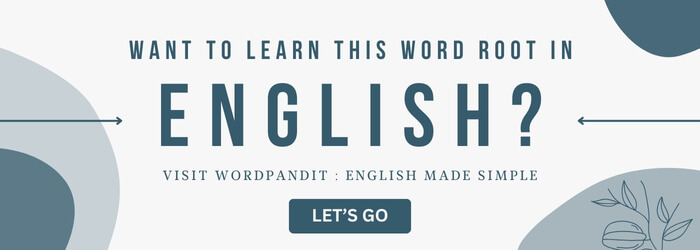Dors: The Backbone of Meaning in Language and Science
(Dors: Bhaasha aur Vigyaan mein Rehniyat - डोर्स: भाषा और विज्ञान में रीढ़)
Explore the linguistic and scientific significance of "dors," a root derived from Latin, meaning "back." From anatomical terms like "dorsal" to actions such as "dorsiflex," this root underpins a rich vocabulary related to structure, movement, and positioning.

Table of Contents
- Introduction: The Backbone of "Dors"
- Etymology and Historical Journey
- Mnemonic: Unlocking the Power of "Dors"
- Common "Dors"-Related Terms
- "Dors" Through Time
- "Dors" in Specialized Fields
- Illustrative Story: "Dors" in Action
- Cultural Significance of "Dors"
- The "Dors" Family Tree
- FAQs about the "Dors" Root
- Test Your Knowledge: "Dors" Mastery Quiz
- Conclusion: The Enduring Legacy of "Dors"
Introduction: The Backbone of "Dors"
("Dors" ki Rehniyat - "Dors" की रीढ़)
Jab aap "dorsal fin" sunte ho, aapke dimaag mein kya aata hai? Shayad ek shark ya dolphin ka back fin? Root "dors," Latin origin se hai aur iska matlab hota hai "back" (पीठ). Biology, anatomy aur movement sciences mein yeh term kaafi use hoti hai, jo iski importance aur relevance ko dikhata hai.

Etymology and Historical Journey
("Dors" ka Itihaas aur Safar - "Dors" का इतिहास और सफर)
"Dors" ka origin Latin word "dorsum" se hai, jo "back" ka arth deta hai. Ancient Rome mein, "dorsum" ka use objects ya living beings ke backside ko describe karne ke liye hota tha. Medieval Latin ke time se yeh word Modern English mein aaya, aur anatomical aur scientific terms mein important ban gaya.
Mnemonic: Unlocking the Power of "Dors"
(Mnemonic se "Dors" yaad karein - Mnemonic से "Dors" याद करें)
Sochiye ek dorsal fin ke baare mein, jo waves cut karte hue ek swimmer ko aage badhne mein madad karta hai. Yeh fin "dors" ka visual reminder hai, jo back ko signify karta hai.
Mnemonic Device:
"Dors yaad dilata hai ki aapka dorsal side aapki back hai, head se toes tak."
Common "Dors"-Related Terms
("Dors" se Jude Shabd - "Dors" से जुड़े शब्द)
- Dorsal (dor-suhl): Back se related.
Example: "Dolphin ka dorsal fin usse water mein steer karne mein help karta hai." - Dorsiflex (dor-si-fleks): Backward ya upward bend karna.
Example: "Walking ke time ankle dorsiflex hoti hai." - Dorsum (dor-sum): Body part ya organ ka back side.
Example: "Hand ka dorsum, palm ke opposite side hota hai." - Dorsoventral (dor-so-ven-tral): Back aur belly sides dono se related.
Example: "Dorsoventral axis anatomical orientation mein kaafi important hai." - Dorsalgia (dor-sal-juh): Back pain ko describe karta hai.
Example: "Long sitting hours ke baad usse dorsalgia hone laga."
"Dors" Through Time
(Samay ke Saath "Dors" ka Safar - समय के साथ "Dors" का सफर)
- Ancient Roots: Latin "dorsum" ka use humans aur animals ke backside ko describe karne ke liye hota tha.
- Medieval Usage: "Dorsal" word anatomy studies ke liye formalize kiya gaya tha.
- Modern Evolution: Aaj ke time mein "dors" anatomy aur movements ko describe karne ke liye medical aur biological contexts mein integral hai.
"Dors" in Specialized Fields
("Dors" ka Vishesh Upyog - "Dors" का विशेष उपयोग)
- Anatomy and Zoology: Words like "dorsal" body orientations ke liye use hote hain.
Example: "Dorsal view ek structure ka back side dikhata hai." - Medicine: "Dorsalgia" back pain ke liye use hota hai, jo ek common medical term hai.
Example: "Long sitting hours se dorsalgia hone ka risk badh jata hai." - Kinesiology: "Dorsiflexion" biomechanics ka ek important term hai, especially foot aur ankle movements ke liye.
Example: "Walking ke time dorsiflexion proper movement ensure karta hai."
Illustrative Story: "Dors" in Action
(Ek Kahani "Dors" ke Mahatva ki - एक कहानी "Dors" के महत्व की)
Emma, ek budding zoologist, ne dolphins ko ocean mein glide karte hue observe kiya. Dolphins ke dorsal fins se inspire hoke, usne aquatic locomotion par study shuru ki. Uske research ne yeh dikhaya ki dorsal fins sirf stability ke liye nahi balki underwater vehicles ke design mein bhi inspiration deti hain. Emma ki kahani nature aur technology ke beech ki connectivity ko dikhati hai.
Cultural Significance of "Dors"
("Dors" ka Sanskritik Mahatva - "Dors" का सांस्कृतिक महत्व)
Kai cultures mein "back" strength aur support ka symbol hota hai. Example ke liye, "on one’s back" burdens carry karna resilience ka metaphor hai. Isi tarah, dorsal imagery art aur literature mein protection aur unseen strength ko represent karti hai.

The "Dors" Family Tree
("Dors" Parivaar ke Related Shabd - "Dors" परिवार के संबंधित शब्द)
- Ventr- (belly): Opposite of dors, ventr belly side ko refer karta hai.
Example: "Ventral fins fish ke underside par hote hain." - Poster- (behind): Peeche ka side dikhata hai.
Example: "Posterior muscles movement ko support karte hain." - Flex (bend): "Dors" ke saath pair hota hai bending movements ko describe karne ke liye.
Example: "Dorsiflexion foot ke back part ko flex karna involve karta hai."

FAQs About the Dors Word Root
(Dors Root se Jude Prashn aur Uttar - Dors से जुड़े सवाल और जवाब)
Q1: "Dors" ka kya matlab hai?
A: "Dors" ka matlab hai "back" (पीठ). Yeh root Latin word "dorsum" se aaya hai aur anatomy, zoology, aur science mein positions ya movements describe karne ke liye use hota hai.
Q2: Dorsal fin kya hota hai?
A: Dorsal fin ek fin hoti hai jo aquatic animals jaise dolphins aur sharks ke back par hoti hai. Iska kaam stability aur balance provide karna hota hai, aur yeh swimming ke dauraan animal ko side-to-side rolling se bachata hai.
Q3: Dorsiflexion ka matlab kya hai?
A: Dorsiflexion body ke ek part ko backward ya upward bend karne ka action hai. Example ke liye, jab aap apne toes ko upar ki taraf lift karte ho, aap apne ankle ka dorsiflexion kar rahe ho.
Q4: Dorsalgia kis cheez ko describe karta hai?
A: Dorsalgia ka matlab hai back pain jo muscular strain, poor posture, ya medical conditions jaise herniated disc ki wajah se ho sakta hai.
Q5: "Dorsal" ka opposite kya hai?
A: "Dorsal" ka opposite hai "ventral," jo body ke belly ya front side ko refer karta hai. Anatomical terms mein, "ventral" structures underside ya front ki taraf hote hain.
Q6: Anatomy mein "dorsum" ka use kaise hota hai?
A: Anatomy mein "dorsum" ek organ ya body part ke back side ko refer karta hai. Example ke liye, hand ka dorsum palm ke opposite side par hota hai.
Q7: Biology mein dorsal view important kyun hai?
A: Biology mein dorsal view organism ke back side ko describe karta hai. Yeh perspective anatomy, behavior, ya adaptations samajhne ke liye kaafi important hota hai.
Test Your Knowledge:Dors Mastery Quiz
(Dors Quiz ke Zariye Apne Gyaan ko Test Karein - Dors क्विज़)
1. What does "Dors" mean? ("Dors" का क्या मतलब है?)
2. What does dorsiflexion describe? (Dorsiflexion क्या दर्शाता है?)
3. What is "Dorsalgia"? (Dorsalgia क्या है?)
4. Which animal is known for having a dorsal fin? (कौन सा जानवर dorsal fin के लिए जाना जाता है?)
5. What is the opposite of "Dorsal"? ("Dorsal" का विपरीत क्या है?)
Conclusion: The Enduring Legacy of "Dors"
("Dors" ki Virasat - "Dors" की विरासत)
"Dors" root ek linguistic aur scientific pillar hai jo anatomy se lekar zoology tak disciplines ko connect karta hai. Yeh humein language aur science ke interconnectedness ke baare mein yaad dilata hai. Jaisey hum explore aur innovate karte hain, "Dors" ka significance structure aur movement ke understanding mein bana rahega.








